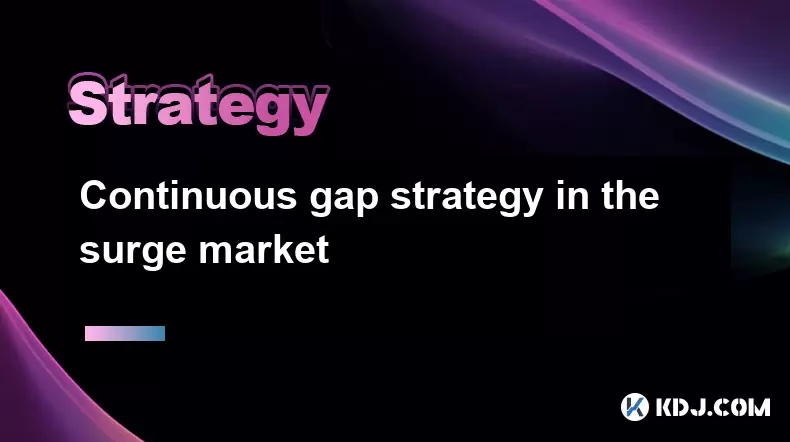-
 bitcoin
bitcoin $122288.232522 USD
0.16% -
 ethereum
ethereum $4480.662914 USD
-0.22% -
 xrp
xrp $2.962747 USD
-2.32% -
 tether
tether $1.000120 USD
-0.05% -
 bnb
bnb $1145.654223 USD
-2.07% -
 solana
solana $227.105217 USD
-1.67% -
 usd-coin
usd-coin $0.999548 USD
-0.02% -
 dogecoin
dogecoin $0.250875 USD
-2.04% -
 tron
tron $0.340654 USD
-0.49% -
 cardano
cardano $0.837968 USD
-2.52% -
 hyperliquid
hyperliquid $48.960449 USD
0.06% -
 chainlink
chainlink $22.049280 USD
-1.33% -
 ethena-usde
ethena-usde $1.000404 USD
0.02% -
 sui
sui $3.586212 USD
0.20% -
 avalanche
avalanche $29.894916 USD
-4.18%
Continuous gap strategy in the surge market
Crypto traders use the continuous gap strategy to exploit price gaps during market surges, aiming to increase profits and manage risks effectively.
Jun 03, 2025 at 03:21 am

The continuous gap strategy is a trading approach that many cryptocurrency traders employ during periods of market surges. This strategy involves identifying and exploiting price gaps in the market, which are typically more pronounced during volatile periods. By understanding how to effectively use the continuous gap strategy, traders can potentially increase their profits and manage risks better. In this article, we will delve into the specifics of the continuous gap strategy, how to identify gaps, and the best practices for executing trades during market surges.
Understanding the Continuous Gap Strategy
The continuous gap strategy revolves around the concept of price gaps, which occur when there is a significant difference between the closing price of one period and the opening price of the next. These gaps are often seen in the cryptocurrency market due to its high volatility, especially during surges. Traders using this strategy aim to capitalize on these gaps by entering and exiting trades at optimal points.
The strategy is called 'continuous' because it involves monitoring the market continuously for new gaps that may form. This requires a keen eye and a deep understanding of market dynamics. Traders need to be ready to act swiftly, as gaps can close quickly, especially in the fast-paced world of cryptocurrencies.
Identifying Gaps in the Market
To effectively use the continuous gap strategy, traders must first learn how to identify gaps in the market. Gaps can be classified into different types, such as breakaway gaps, runaway gaps, and exhaustion gaps. Each type of gap indicates different market conditions and potential trading opportunities.
- Breakaway gaps occur at the beginning of a trend and signal a strong move away from a previous trading range. These are often seen at the start of a surge.
- Runaway gaps happen during a trend and indicate that the trend is likely to continue. They are common during sustained market surges.
- Exhaustion gaps appear near the end of a trend and suggest that the trend is running out of steam. These are important to recognize as they can signal the end of a surge.
Traders can use various tools and indicators to identify these gaps. Candlestick charts are particularly useful, as they clearly show the opening and closing prices of each period. Additionally, volume indicators can help confirm the strength of a gap, as high volume often accompanies significant gaps.
Executing Trades with the Continuous Gap Strategy
Once a trader has identified a gap in the market, the next step is to execute trades effectively. The continuous gap strategy involves entering a trade shortly after a gap forms and exiting before the gap closes. Here are the steps to execute trades using this strategy:
- Monitor the market continuously: Use real-time data and charting tools to keep an eye on price movements and identify new gaps as they form.
- Enter the trade: Once a gap is identified, enter the trade in the direction of the gap. For example, if a breakaway gap forms to the upside, enter a long position.
- Set stop-loss orders: To manage risk, set a stop-loss order below the gap for long positions or above the gap for short positions. This helps limit potential losses if the market moves against the trade.
- Monitor the trade: Keep an eye on the trade and be ready to exit if the gap starts to close. The goal is to capture the majority of the gap before it closes.
- Exit the trade: Exit the trade once the gap has been partially filled or if other market indicators suggest that the trend is changing.
Risk Management in the Continuous Gap Strategy
Risk management is crucial when using the continuous gap strategy, especially during market surges. The high volatility of the cryptocurrency market can lead to rapid price movements, and traders need to be prepared for both potential profits and losses.
One key aspect of risk management is position sizing. Traders should only risk a small percentage of their trading capital on each trade to avoid significant losses. Additionally, using stop-loss orders is essential to limit potential losses if the market moves against the trade.
Another important element of risk management is diversification. Traders should not put all their capital into a single trade or asset. Instead, they should spread their risk across multiple trades and assets to reduce the impact of any single loss.
Tools and Indicators for the Continuous Gap Strategy
To effectively implement the continuous gap strategy, traders need to use the right tools and indicators. Here are some of the most important ones:
- Candlestick charts: These charts provide a clear visual representation of price movements and gaps. They are essential for identifying and analyzing gaps in the market.
- Volume indicators: High volume often accompanies significant gaps, so volume indicators can help confirm the strength of a gap and the likelihood of it continuing.
- Moving averages: These can help traders identify trends and potential reversal points. They are useful for determining whether a gap is part of a larger trend or a short-term anomaly.
- Relative Strength Index (RSI): This momentum indicator can help traders identify overbought or oversold conditions, which can be useful for determining when to enter or exit trades.
Case Studies of the Continuous Gap Strategy
To better understand how the continuous gap strategy works in practice, let's look at a few case studies from the cryptocurrency market.
- Case Study 1: During a recent Bitcoin surge, a breakaway gap formed as the price broke out of a consolidation range. Traders who identified this gap and entered long positions shortly after it formed were able to capture significant profits as the price continued to rise.
- Case Study 2: In another instance, an exhaustion gap formed near the end of an Ethereum surge. Traders who recognized this gap and exited their long positions before the gap closed were able to lock in profits and avoid potential losses as the price began to decline.
These case studies illustrate the importance of identifying and acting on gaps in the market, as well as the need for swift decision-making and effective risk management.
Frequently Asked Questions
Q: Can the continuous gap strategy be used in other financial markets besides cryptocurrencies?A: Yes, the continuous gap strategy can be applied to other financial markets such as stocks, forex, and commodities. However, the effectiveness of the strategy may vary depending on the market's volatility and trading volume. In cryptocurrency markets, the high volatility often results in more pronounced gaps, making the strategy particularly suitable.
Q: How does the continuous gap strategy differ from other gap trading strategies?A: The continuous gap strategy focuses on monitoring the market continuously for new gaps and acting swiftly to capitalize on them. Other gap trading strategies might involve waiting for specific conditions or patterns to form before entering a trade. The continuous gap strategy is more proactive and requires constant vigilance.
Q: What are the key challenges of using the continuous gap strategy during market surges?A: The main challenges include the need for constant monitoring of the market, the rapid pace at which gaps can form and close, and the high volatility that can lead to significant price movements. Traders must be prepared to act quickly and manage their risks effectively to succeed with this strategy.
Q: Are there any specific cryptocurrencies that are better suited for the continuous gap strategy?A: While the continuous gap strategy can be applied to any cryptocurrency, it tends to be more effective with highly volatile assets such as Bitcoin, Ethereum, and other major cryptocurrencies. These assets often experience larger gaps due to their high trading volumes and liquidity.
Disclaimer:info@kdj.com
The information provided is not trading advice. kdj.com does not assume any responsibility for any investments made based on the information provided in this article. Cryptocurrencies are highly volatile and it is highly recommended that you invest with caution after thorough research!
If you believe that the content used on this website infringes your copyright, please contact us immediately (info@kdj.com) and we will delete it promptly.
- BlockDAG, DOGE, HYPE Sponsorship: Crypto Trends Shaping 2025
- 2025-10-01 00:25:13
- Deutsche Börse and Circle: A StableCoin Adoption Powerhouse in Europe
- 2025-10-01 00:25:13
- BlockDAG's Presale Buzz: Is It the Crypto to Watch in October 2025?
- 2025-10-01 00:30:13
- Bitcoin, Crypto, and IQ: When Genius Meets Digital Gold?
- 2025-10-01 00:30:13
- Stablecoins, American Innovation, and Wallet Tokens: The Next Frontier
- 2025-10-01 00:35:12
- NBU, Coins, and Crypto in Ukraine: A New Yorker's Take
- 2025-10-01 00:45:14
Related knowledge

Practical parameter settings for a Bitcoin multi-timeframe moving average system
Sep 18,2025 at 10:54pm
Optimizing Timeframe Combinations for Bitcoin Trading1. Selecting appropriate timeframes is crucial when building a multi-timeframe moving average sys...

How can I filter out false breakouts in Dogecoin high-frequency trading?
Sep 22,2025 at 01:00am
Understanding False Breakouts in Dogecoin Trading1. A false breakout occurs when Dogecoin's price appears to move beyond a defined support or resistan...

Techniques for identifying tops and bottoms in the Bitcoin on-chain NVT model
Sep 20,2025 at 07:54pm
Understanding the NVT Model in Bitcoin Analysis1. The Network Value to Transactions (NVT) ratio is often described as the 'P/E ratio' of the cryptocur...

What does the surge in open interest in Bitcoincoin futures mean?
Sep 20,2025 at 11:18pm
Understanding the Surge in Dogecoin Futures Open Interest1. A surge in open interest within Dogecoin futures indicates a growing number of active cont...

How can I use the Ethereum USDT premium to gauge market sentiment?
Sep 18,2025 at 11:55pm
Understanding the Ethereum USDT Premium1. The Ethereum USDT premium refers to the price difference between USDT (Tether) traded on Ethereum-based plat...

What should I do if Ethereum staking yields decline?
Sep 20,2025 at 06:18am
Understanding the Causes Behind Declining Ethereum Staking Yields1. The Ethereum network transitioned to a proof-of-stake consensus mechanism with the...

Practical parameter settings for a Bitcoin multi-timeframe moving average system
Sep 18,2025 at 10:54pm
Optimizing Timeframe Combinations for Bitcoin Trading1. Selecting appropriate timeframes is crucial when building a multi-timeframe moving average sys...

How can I filter out false breakouts in Dogecoin high-frequency trading?
Sep 22,2025 at 01:00am
Understanding False Breakouts in Dogecoin Trading1. A false breakout occurs when Dogecoin's price appears to move beyond a defined support or resistan...

Techniques for identifying tops and bottoms in the Bitcoin on-chain NVT model
Sep 20,2025 at 07:54pm
Understanding the NVT Model in Bitcoin Analysis1. The Network Value to Transactions (NVT) ratio is often described as the 'P/E ratio' of the cryptocur...

What does the surge in open interest in Bitcoincoin futures mean?
Sep 20,2025 at 11:18pm
Understanding the Surge in Dogecoin Futures Open Interest1. A surge in open interest within Dogecoin futures indicates a growing number of active cont...

How can I use the Ethereum USDT premium to gauge market sentiment?
Sep 18,2025 at 11:55pm
Understanding the Ethereum USDT Premium1. The Ethereum USDT premium refers to the price difference between USDT (Tether) traded on Ethereum-based plat...

What should I do if Ethereum staking yields decline?
Sep 20,2025 at 06:18am
Understanding the Causes Behind Declining Ethereum Staking Yields1. The Ethereum network transitioned to a proof-of-stake consensus mechanism with the...
See all articles










































































